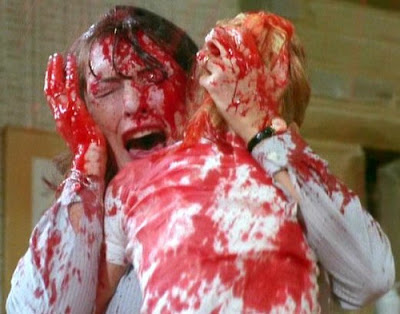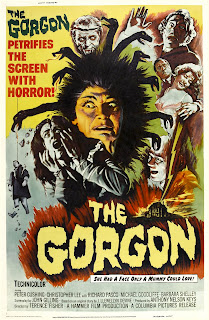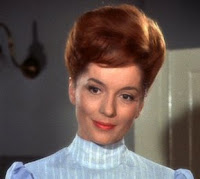The House That Bled To Death is a double-twist shocker featuring a priceless scene where a pipe spurts blood over children at a party. A family move into the dilapidated abode where a man had carved up his wife with an ornamental machete, though the new owners have an Amityville-like agenda of their own.
TELEVISION always served Hammer films well. After all, if it wasn't for the success of their adaptation THE QUATERMASS XPERIMENT, it is likely that their vivid re-imaginings of Frankenstein and Dracula would have never been made. By the 1970s, Hammer's usual output of costumed gothique was in its death throes, slices of entertainment that seemed frozen in time. However, the studio's big screen spin-off of ON THE BUSES was a box-office phenomenon, leading the studio on a comedic vein which included LOVE THY NEIGHBOUR and MAN ABOUT THE HOUSE. Hammer's attempts to make TV projects of their own resulted in four separate ventures; the series under consideration here was followed by HAMMER HOUSE OF MYSTERY AND SUSPENSE, but earlier projects were TALES OF FRANKENSTEIN - an abortive pilot starring Anton Diffring - and seventeen episodes of JOURNEY TO THE UNKNOWN.
British horror had largely become past tense from the mid-70s; Tigon's last official release was the sex film COME PLAY WITH ME, and Amicus ceased production after THE PEOPLE THAT TIME FORGOT in 1979, the same year in which Hammer called in the receivers. But two former board members, Brian Lawrence and Roy Skeggs, assumed control and immediately began looking at ways to revitalise the company. Lawrence and Skeggs needed a new base of operations and leased Hampden House in Buckinghamshire - close to Hammer's spiritual home of Bray - to develop a new series for television. A former private house and exclusive Girl's School, the majestic property and surrounding areas are used ad infinitum, and most of the production, including the editing, was overseen there. Assembling their crew, the two men unsurprisingly drafted in a number of former Hammer employees, including directors Peter Sasdy, Alan Gibson and Don Sharp, visual effects man Ian Scoones, and James Bernard scored two stories.
British horror had largely become past tense from the mid-70s; Tigon's last official release was the sex film COME PLAY WITH ME, and Amicus ceased production after THE PEOPLE THAT TIME FORGOT in 1979, the same year in which Hammer called in the receivers. But two former board members, Brian Lawrence and Roy Skeggs, assumed control and immediately began looking at ways to revitalise the company. Lawrence and Skeggs needed a new base of operations and leased Hampden House in Buckinghamshire - close to Hammer's spiritual home of Bray - to develop a new series for television. A former private house and exclusive Girl's School, the majestic property and surrounding areas are used ad infinitum, and most of the production, including the editing, was overseen there. Assembling their crew, the two men unsurprisingly drafted in a number of former Hammer employees, including directors Peter Sasdy, Alan Gibson and Don Sharp, visual effects man Ian Scoones, and James Bernard scored two stories.
Diana Dors and her brood in Children of the Full Moon, a long way from Oliver Reed and THE CURSE OF THE WEREWOLF.
Funded by ITC and screened between 13th September and 6th December 1980, the 13 episodes of the HAMMER HOUSE OF HORROR were refreshingly bleak, mixing contemporary horror and titillation in the manner of Norman J. Warren (with Frankenstein and Dracula nowhere in sight). Hampered by meagre budgets, pedestrian scripts and flat direction, the fifty-minute stories are surprisingly watchable, thanks to their variety of topics - devil worship, time-travelling witches, cannibalism and Nazi pet shop owners - and stars such as Hammer favourites Peter Cushing, John Carson and Robert Urquhart, together with Brian Cox, Jon Finch and Warren Clarke et al (a young Pierce Brosnan appears as a randy jogger victim, a character so incidental that he's even denied an onscreen death).
HAMMER HOUSE OF HORROR falls into that notion lovingly referred to as guilty pleasures. Even the worst entry, Carpathian Eagle, stars Suzanne Danielle as a psychotic seductress/writer who rips out the heart of her victims with a dagger. The best two episodes hold up as memorable slabs of TV horror: The Two Faces of Evil is a dazzling doppelganger yarn with a genuinely jolting prologue, and the delirious The Mask of Satan sees a morgue worker believing he has a disease engineered to bring Satan to Earth. The rest of the output fall somewhere in between; at least Rude Awakening attempts something different in its total abandonment of logic, with adulterous estate agent Denholm Elliott persistently accused of murdering his wife; and VAMPIRE CIRCUS helmer Robert Young brings some stylish flourishes to the voodoo-themed Charlie Boy.









